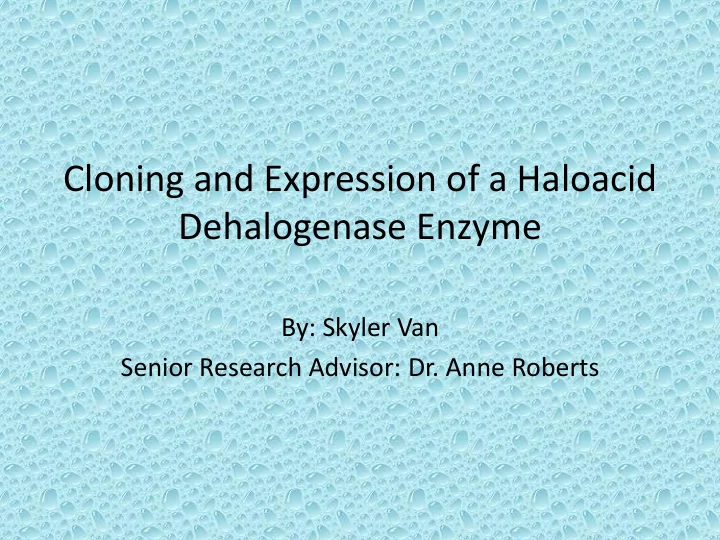

Cloning and Expression of a Haloacid Dehalogenase Enzyme By: Skyler Van Senior Research Advisor: Dr. Anne Roberts
Outline • The gene being cloned is JHP1130 from Helicobacter pylori ( H. pylori ) • JHP1130 is a member of the Haloacid Dehalogenase (HAD) superfamily • The gene was cloned into a pet21b vector for subsequent expression • The plasmid was transformed into BL21 E. coli cells for protein expression • The expected molecular weight of the desired protein was roughly 25 kDa and a band at this molecular weight confirmed the presence of the correct protein.
H. Pylori bacterium
Members of the Haloacid dehalogenase (HAD) superfamily have diverse functions Cl - Cl - H H H H E-ASP intermediate Cl E-ASP E-ASP OH E-ASP intermediate Cl R E-ASP E-ASP R OH R R COO - COO - COO - COO - Dehalogenases ROH O O ROH O O - O - O P OH E-ASP E-ASP intermediate E-ASP P OR - O - O P OH E-ASP E-ASP intermediate E-ASP P OR O - O - O - O - Phosphatases E-ASP Mannose-6-Phosphate E-ASP intermediate E-ASP Mannose-1-Phosphate E-ASP Mannose-6-Phosphate E-ASP intermediate E-ASP Mannose-1-Phosphate Phosphomutases NH 2 N N N ADP N O O O H H O H H OH H E-ASP intermediate E-ASP + P i E-ASP -O P O P O P O O- O- O- P-type ATPases (Ion pumps)
JHP 1130 • Putative member of the HAD phosphatase superfamily, members of which are found in many metabolic pathways R O P H 2 O O O O O Pi P R O - O O O O - O O Phosphorylated E-ASP Enzyme intermediate
Had members can be identified by the presence of specific sequence motifs MOTIF I D X D X[T/V][L/V] ( P-type ATPases) D KTGTL first aspartate becomes phosphorylated second aspartate involved in binding Mg 2+ required for activity MOTIF II [ S / T ]XX involved in phosphoryl oxygen binding MOTIF III K -[G/S][D/S]XXX[D/N] (HAD) SSXXXD involved in phosphoryl oxygen binding and binding of Mg 2+
PCR of JHP1130 Requirements Insert w/ histag for PCR: Insert w/ histag • dNTP’s Insert w/ histag • genomic DNA Insert w/ histag • primers • polymerase Insert w/o histag • Mg 2+ Insert w/o histag • small amount Insert w/o histag of ddNTP Insert w/o histag DNA ladder • Forward primer (Nde1): • 5’ – GCT GAC CAT ATG GCG CTT GAA GTG GTT TTA TGG – 3’ • Reverse primer (Ecor1 w/o histag): • 5’ – GCA GTC GAA TTC TTA CTC TTT TGC GAA GTT TTG TAA ATC – 3’ • Reverse primer (Xho1 w/ histag): • 5’ – ACA TCG CTC GAG CTC TTT TGC GAA GTT TTG TAA ATC – 3’
pET – 21 b (+)
General cloning strategy pET21b Plasmid Plasmid Insert Cleaved --CA TATG + pET21b --GTAT AC-- Plasmid DNA LIGASE JHP1130 CA TATG gene insert GTAT AC Plasmid w/ insert integrated
Cleaved Gene Insert and Plasmid nde1/xho1 insert w/ histag nde1/ecor1 insert w/o histag nde1/ecor1 plasmid digest w/o histag nde1/xho1 plasmid digest w/ histag • Ran gels containing insert and plasmid cleaved with each of the restriction endonucleases • Cut out the portion of gel with the bands corresponding to each product • Extracted the DNA from the gel for each product. • This ensured that the products were free of impurities before ligation reaction was performed.
Transformation of JHP1130 plasmid into DH5 α cells Luria Bertani Ampicillin/agar plate broth w/ DH5 α cells : ampicillin • The plasmid with the insert incorporated is grown with DH5α cells • Specially designed to allow passage of plasmid through cell membrane • This permeability makes the cells very fragile
Testing for JHP1130 insert in Plasmid DNA ladder #1 T7 promoter/terminator PCR reaction #2 T7 promoter/terminator PCR reaction Plasmid control
Plasmid containing JHP1130 transformed into BL21 cells 75 kDa 50 kDa 25 kDa Isopropyl β -D-1- thiogalactopyranoside(IPTG): • IPTG is used for protein expression From left to right: Protein standard, BL21 • It mimics allolactose, but not Transformation #1, BL21 Transformation #2, w/ IPTG #1, w/ IPTG #2 as easily degraded • Binds to lac repressor allowing transcription (JHP1130)
Purification via Ion Exchange JHP1130 facts: • pI = 5.67 Increasing [NaCl] • M.W. = 25440.9 Da • Number of Amino Acids = 222 75 kDa 50 kDa 25 kDa Ion exchange chromatography setup: • pH =8 (protein is negatively charged) • Q sepharose anion exchange column • to elute protein increase the salt concentration
Ammonium Sulfate Fractionation Saturated Ammonium 75 kDa 50 kDa Sulfate facts: • Different proteins will precipitate at different 25 kDa percentages • JHP1130 has a molecular weight of ~25 kDa • The first lane with a band at ~25 kDa is 55% saturation From right to left: protein ladder, 20%, 40%, 55%, 65%, 80%, protein ladder
Future research • Purify protein to homogeneity • Begin testing various small molecule phosphorylated substrates to narrow down in vivo substrate
Questions
Recommend
More recommend